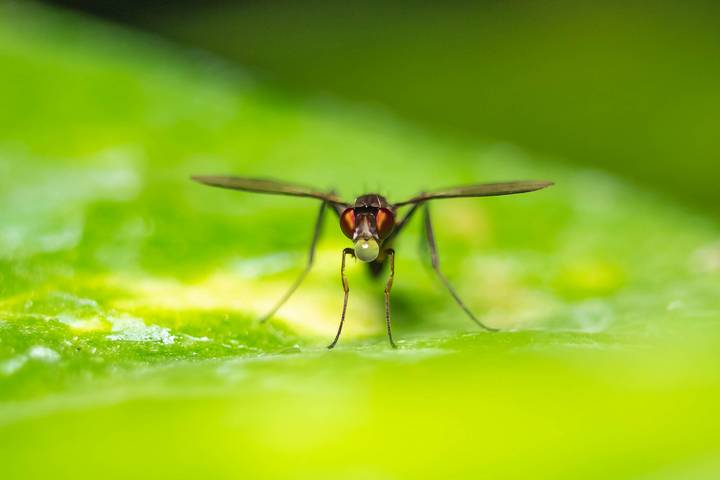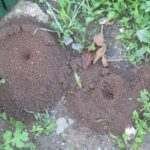
Soaring termite swarmers, also known as flying termites, are reproductive members of their clan, gifted with wings. Their ultimate goal? To create new termite colonies. These airborne termites bid farewell to their current colony en masse at various times throughout the year. They set off to find a mate and an ideal spot to kick-start their new settlement. Drawn like moths to a flame, they’re known for congregating near light sources, such as lampposts or windows.
Termites are indispensable in our ecosystem — they help break down dead plant matter. However, their reputation precedes them in structures and residences. The mention of termites sends shivers down homeowners’ spines, as these critters are infamous for wreaking havoc on wooden structures and jeopardizing building safety. As such, spotting flying termites signifies an active infestation or the potential for one — a clear red flag that demands swift action.
Effectively addressing flying termites requires taking care of the immediate swarmers and their hidden colony. Regular inspections and keeping your building well-maintained can offer protection by helping identify and treat infestations early on. When faced with flying termite intruders, seeking professional pest control services is crucial. They can thoroughly evaluate an infestation and employ proper termite treatment tactics.
With prompt action and preventative strategies, you can defend your property from these winged wrecking balls and maintain a termite-free sanctuary. Let’s learn how to get rid of flying termites.
Professional termite treatment.
Skilled pest control experts possess the know-how and specialized equipment to pinpoint termite colonies precisely. They can evaluate the infestation scope and determine a suitable treatment strategy. They can use liquid termiticides, bait systems, or fumigation depending on the situation. Professional termite treatments also deal with the core termite colonies, ensuring thorough extermination and lasting defence against future invasions.
Choose a credible and seasoned pest control firm for the best termite treatment. They will inspect your property, identify susceptible spots, and offer a tailor-made treatment plan. Professional treatments boast a higher success rate than DIY methods, employing cutting-edge products and tactics specifically crafted to ward off termites.
Eliminate moisture sources.
Eliminating moisture establishes an unwelcoming environment for termites, decreasing the odds of them invading your property. Begin by addressing any plumbing leaks; dripping faucets or pipes supply a steady stream of water that attracts termites. Ensure that gutters and downspouts work efficiently, channelling water away from your home’s foundation. Enhancing drainage around your estate and redirecting water flow deters excess moisture accumulation.
Promoting proper ventilation throughout your dwelling is an excellent way to diminish moisture sources. Efficient airflow lowers humidity levels, making termites less hospitable. Deploy dehumidifiers in damp-prone spaces such as basements, crawl spaces, or washrooms. Additionally, consider using moisture barriers or waterproofing solutions where moisture leakage is worrisome. You foster a less termite-friendly setting by eradicating moisture sources, lowering infestation risks.
Remove wooden debris.
Termites find wood a delightful meal, meaning any wooden fragments or rotting wood near your property may be a welcoming treat for these unwanted guests. Begin by surveying your yard and disposing of stray branches, tree stumps, or scattered logs. These create perfect hideouts and feasting spots for termites, increasing infestation chances.
Beyond natural wood clutter, it’s vital to tackle wooden items with neglect. Outdated wooden structures, disregarded furniture, or external wood pallets can lure termites and act as nesting grounds. Removing or responsibly disposing of such items is essential to prevent potential termite dwelling spaces. Regularly checking your property for wood debris traces and swiftly addressing the issue establishes an environment less appealing to termites.
Seal entry points.
Flying termites can infiltrate through the tiniest crevices and gaps, emphasizing the need to pinpoint and seal possible entryways. Begin by scrutinizing the exterior of your property, paying close attention to spots where utilities penetrate the building. These spots include plumbing pipes, electrical cables, and communication lines. Ensure that any openings around these entry points are filled with caulk or weatherstripping to create an impenetrable barrier against termites.
Assess doors and windows for openings or gaps. If so, ensure they are adequately sealed. Use weatherstripping or door sweeps to close spaces around doors and windows’ edges. Replace damaged screens and consider installing fine mesh screens on windows and vents to avert termite entry.
Inspecting and sealing any cracks in your property’s foundation, walls, and siding is crucial. Securing these access points diminishes the likelihood of flying termites infiltrating your indoor space.
Use termite baits.
Termite baits feature slow-release insecticides meticulously placed within feeding locales or traps encircling your property. Irresistible to termites, these appealing substances draw insects towards stations. As termites feast on the bait and transport it back to the colony, the substance permeates the entire population, reaching the queen and other members. Consequently, this hinders their reproductive process, ultimately causing the colony’s downfall.
Termite baits provide numerous merits. They champion eco-friendliness by reducing chemical insecticide usage and harming humans or pets. They also tackle the termite colony, ensuring extended control and averting potential infestations. These baits are unobtrusive, eliminating the need for extensive drilling or digging around the property.
Repair damaged wood.
Termites have an affinity for wood, feasting upon it with gusto, making any existing areas of decayed or damaged wood suitable targets for infestation. Vigilantly inspect your property for any indicators of termite havoc, such as hollowed or weakened wood structures, mud tubes, or frass (the fancy term for termite droppings). Pinpoint and prioritize repair or replacement zones.
Start the process by removing and replacing any severely damaged or compromised wood. This endeavour could entail replacing entire segments of wooden structures, including beams, floors, or siding. The replacement wood must be top-notch quality and aptly treated to prevent termite infestation.
Consider treating the repaired or replaced wood with a termite-resistant concoction or coating to protect against future infestations. By swiftly repairing damaged wood, you can eliminate appealing food sources for flying termites and diminish the likelihood of additional structural damage to your property.
Regular termite inspections.
Termites tend to be discreet invaders, causing substantial harm to structures before their existence is noticed. By performing regular termite inspections, you can spot possible termite activities and take proactive steps to lessen the risk of invasion. Skilled termite inspectors can identify termite presence indications, such as mud tubes, shed wings, or wood damage.
Throughout a termite inspection, the inspector will meticulously scrutinize your property’s interior and exterior, including crawl spaces, basements, attics, foundations, and wooden structures. They will evaluate the wood’s condition, inspect potential entry points and search for evidence of termite activity.
If termites are discovered, the inspector can suggest treatment alternatives or preventive measures to safeguard your property. Consistent termite inspections offer you peace of mind, allowing you to stay ahead of potential termite infestations. You can take prompt action to shield your home or building from flying termites.












